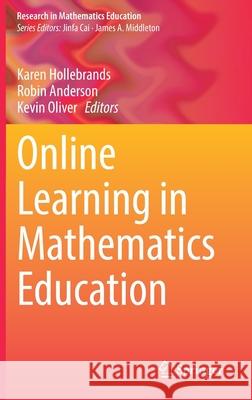Online Learning in Mathematics Education » książka



Online Learning in Mathematics Education
ISBN-13: 9783030802295 / Angielski / Twarda / 2021 / 366 str.
Online Learning in Mathematics Education
ISBN-13: 9783030802295 / Angielski / Twarda / 2021 / 366 str.
(netto: 651,74 VAT: 5%)
Najniższa cena z 30 dni: 655,41
ok. 22 dni roboczych
Bez gwarancji dostawy przed świętami
Darmowa dostawa!
"This book's strength is that it is multidimensional, rich in theory, practice, research, references, and technology associated with supporting mathematics educators through and towards online learning. This book is a great source of knowledge, and we appreciate the placement of the chapters into each section. The chapter organization within each section provides the reader with a logical progression of conceptual understanding, experience, examples, and empirical research. ... we recommend that anyone interested in online mathematics education should read this book." (Marfuah Marfuah, Rita Novita and Sri Wulandari Danoebroto, Educational Studies in Mathematics, Vol. 112 (2), 2023)
Introduction - Hollebrands, Anderson and Oliver
Section 1: Design of Online Learning Experiences in Mathematics Education (4)
Chapter 1: Marcelo C. Borba, Johann Engelbrecht and Salvador Llinares. Using digital technology and blending to change the mathematics classroom.
Chapter 2: Angie Hodge-Zickerman, Patrick R. Lowenthal, and Cindy S. York. Teaching mathematics education online: Instructional design theories, strategies, and technologies
Chapter 3: Naomi Jessup, Jennifer Wolfe, and Crystal Kalinec-Craig. Rehumanizing mathematics education and building community in online spaces
Chapter 4: Dung Tran and Giang-Nguyen T. Nguyen. Keep human interaction present in online mathematics education methods courses - lenses of educators across institutions
Section 2: Formal Online Learning Experiences for Prospective Teachers (7)
Chapter 5: Jeannette D. Alarcón, Carrie S. Cutler, Jennifer B. Chauvot, and Susie L. Gronseth. Applying critical pedagogy and UDL to synchronous online course design to equip pre-service teachers in mathematical discourse
Chapter 6: Yves Kreis, Ben Haas, Zsolt Lavicza, and Robert Weinhandl Transition from traditional over hybrid towards online courses for pre-service elementary school teachers at the University of Luxembourg
Chapter 7: Hollylynne Lee, Rick Hudson, Stephanie Casey, Gemma Mojica, William Finzer, Heather Barker, and Taylor Harrison. Preparing teachers to teach statistics through online curriculum modules: Design, implementation, and results
Chapter 8: Ceneida Fernández, Salvador Llinares, and Yoilyn Rojas. The impact of an online teacher education program on the development of prospective secondary mathematics teachers’ noticing
Chapter 9: Ji-Yeong I, Christa Jackson, and Ricardo Martinez. Online learning to teach mathematics for emergent bilinguals
Chapter 10: Suparna Chatterjee, Germain Degardin, Wanda Bulger-Tamez, Erika Acosta, Rachel Boren. Restructuring content assessment in mathematics teacher education courses using digital interactive notebooks
Chapter 11: Simon Byeonguk Han and Eva Thanheiser. Number Talks in asynchronous online classrooms for more equitable participation and formative assessment of student thinking.
Section 3: Formal Online Learning Experiences for Practicing Teachers (5)
Chapter 12: Nathan A. Hawk, Margaret A. Bowman, and Kui Xie. Theory-based intervention framework to improve mathematics teachers’ motivation to engage in online professional development
Chapter 13: Jeffrey Choppin, Julie Amador, Cindy Callard, Cyndi Carson, Ryan Gillespie, Jen Kruger, and Stephanie Martin A Three-Part Synchronous Online Model for Middle Grades Mathematics Teachers’ Professional
Chapter 14: Armando Paulino Preciado Babb and Ayman Aljarrah. Contemporary, emergent mathematics for teachers: A case study on an online graduate program
Chapter 15: Aimee J. Ellington, Jamey Lovin, Kristina Anthony, Heather Nunnally, Erica R. Miller & V. Rani Satyam Preparing K-8 mathematics specialists in an (a)synchronous flipped online program
Chapter 16: Verónica Vargas-Alejo and Luis E. Montero-Moguel. Didactic sequence implemented in an online modeling course for inservice teachers.
Section 4: Informal and Self-Directed Learning (4)
Chapter 17: Ferdinando Arzarello, Ornella Robutti, and Eugenia Taranto. MOOCs for in-service mathematics teachers’ professional development: background and reflections of an Italian experience background and reflections of an Italian experience
Chapter 18: Anne Garrison Wilhelm and Jaymie Ruddock. Tweeting to Learning: Professional Networks of Mathematics Teachers on Twitter.
Chapter 19: Erica Miller and Emily Braley. A distributed leadership model for online reading groups
Chapter 20: Yi-Jung Lee. Support elementary preservice teachers’ ability to design real-world tasks through organizing and mathematizing online resources
Section 5: Experiential and Practice-Based Learning (5)
Chapter 21: Amanda Milewski, Irma Stevens, and Patricio Herbst. Confronting teachers with contingencies as a way to support their learning about situation-specific pedagogical decisions in an online context
Chapter 22: Allison McCulloch and Michelle Stephan. Online methods course with practice component.
Chapter 23: Laurie Cavey and Patrick R. Lowenthal. Designing video-based interventions for future secondary teachers: The VCAST story
Chapter 24: Karl Kosko, Rick Ferdig, Enrico Gandolfi, Christine K. Austin, and Maryam Zolfaghari. Virtualizing mathematics field experiences with 360 video.
Chapter 25: Liza Bondurant. Gaining confidence, knowledge, and skills through virtual rehearsals
Conclusion - Hollebrands, Anderson, Oliver
This book brings together research from mathematics education and instructional design to describe the development and impact of online environments on prospective and practicing teachers’ learning to teach mathematics. The move to online learning has steadily increased over the past decade. Its most rapid movement occurring in 2020 with most instruction taking place remotely. Chapters in this book highlight issues related to teacher learning in three main contexts: formal, informal, and experiential or practice-based. This volume brings together researchers from the different but related fields of instructional design and mathematics education to engage in dialogue around how we design and study the impacts of online learning in general and online mathematics education more specifically.
The book is very timely with most instruction taking place online and mathematics educators addressing challenges related to supporting teachers’ formal, informal, and experiential learning online. A chapter in each section will synthesize ideas presented by instructional designers and mathematics educators as it relates to teacher learning in each context. At the end of each section, a retrospective chapter is presented to reflect on what the different perspectives offer to better understand mathematics teacher learning in online environments.
This book is of interest to mathematics educators, researchers, teacher educators, professional development providers, and instructional designers.
1997-2025 DolnySlask.com Agencja Internetowa
KrainaKsiazek.PL - Księgarnia Internetowa









